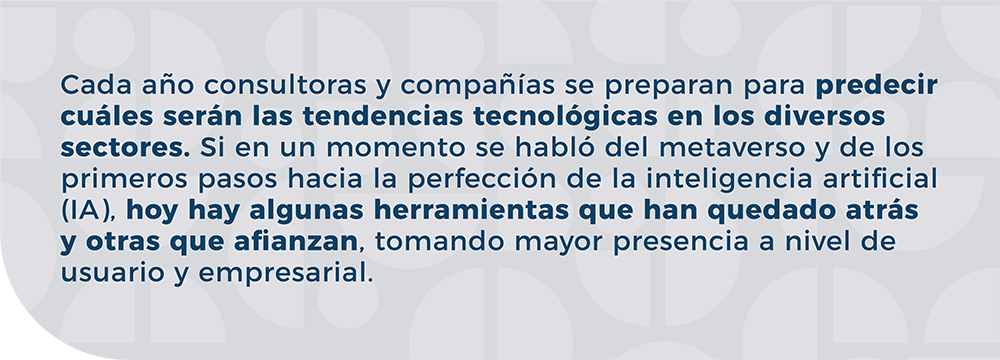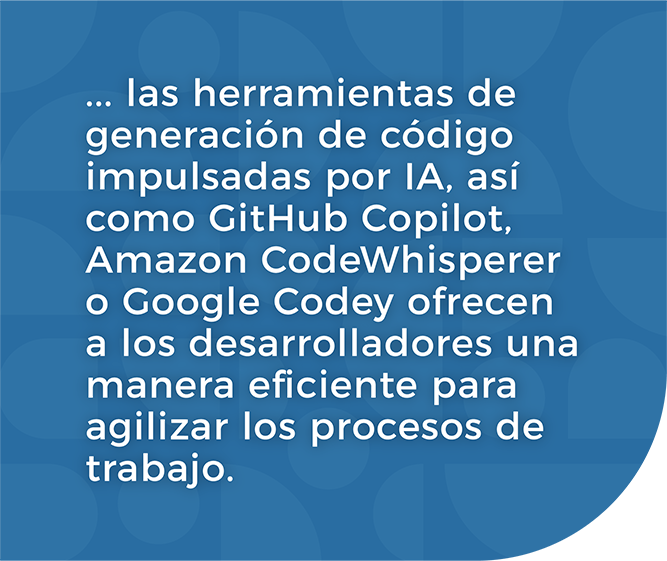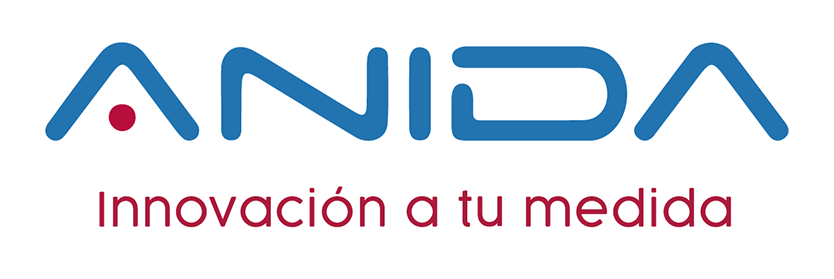
New technologies: the trends that will take over in 2024
Democratization of generative AI, further AI-driven development, robots or systems that will behave like clients, among others, are some of the tools that the prestigious consulting firm Gartner highlights as a driving force for companies over the next twelve months.

As it does every year, the technology consulting firm Gartner has identified the trends that will be key players in 2024. Here we review the main ones:
1. The democratization of generative IA will become a reality.
Generative AI (GenAI), notes Gartner, will give companies a competitive advantage by streamlining processes and fostering creativity. Moreover, by being accessible to a variety of industries and different profiles, it will enable more people to incorporate automation into their work activities.
This, they say, will drive innovation and efficiency in a variety of fields, ranging from content creation to solving complex problems within organizations. Because of this, it is thought that GenAI will have the potential to transform the way we work and create, democratizing technology and improving productivity.
As benefits, they claim that workforce productivity will increase, because they will have access to technical knowledge and skills that were previously impossible, and multi-domain applications will be improved.
However, they also point out that there could be loss of confidential data, copyright issues, possible misuse and "unintended consequences" of these. In order for this not to happen, there must be support for improvements in governance and responsible practices in the use of AI.
2. There will be AI-enhanced development
The inclusion of AI in software development is a growing trend throughout the entire product lifecycle, from code writing to application modernization.

Gartner says that AI-powered code generation tools such as GitHub Copilot, Amazon CodeWhisperer or Google Codey offer developers an efficient way to streamline work processes. Despite that, they argue that it is essential to consider the eventual privacy and intellectual property implications and risks when using these large language models. The latter, particularly when using non-enterprise models, such as ChatGPT or Google Bard.
However, the consultancy highlights that generative AI can be used to identify and manage the apparent technical gap that exists in the sector, providing valuable information on risks and costs in development decisions.
In addition, since ChatGPT can translate software code from one language to another, it can be used to modernize applications and meet user expectations for products and services that are supported by these tools. Added to this is the possibility of using AI for software testing and shortening delivery times.
3. The rise of the industrial cloud platforms.
Industrial Cloud Platforms (ICP) are designed to meet the specific needs of different industry sectors and offer tailored solutions. They combine software, platform and infrastructure as a service to address the unique business, data and compliance requirements of different segments.
In this way, they enable companies to quickly adapt their industrial processes and applications, fostering the ability to change. They also facilitate collaboration between multiple software and systems providers, enriching the industry's cloud ecosystems.
To realize their potential, says Gartner, these platforms are expected to evolve into "ecosystem clouds," which will involve the collaboration of various IT and organizational stakeholders in the line of business. They expect that by 2027, enterprises will use them to accelerate more than 50% of their critical business initiatives. These were less than 10% in 2021 and less than 15% in 2023.
4. Towards a more sustainable technology
Sustainable technology, key to 2024 according to Gartner, focuses on digital solutions that drive environmental, social and governance (ESG) outcomes.

Gartner says the goal is to drive ESG results in internal IT operations, where they seek to reduce emissions and ensure ethical practices; enterprise operations should benefit from automation, artificial intelligence, advanced analytics and the use of the cloud to promote sustainability; and customer operations, where they offer products and services that help users achieve their sustainability goals.
5. Increase in "machine customers".
This term refers to computer systems, devices or applications that act as consumers of services or information, which are generally part of an automated or autonomous environment.
These correspond to programs or devices that interact with servers or other systems to obtain data, make transactions or perform actions without the direct intervention of a human operator.

"Custobots" are common in the realm of AI, automation or IoT, where devices and software can communicate to collect data or make decisions. Gartner says these machine clients can be chatbots or any other technology that allows a system to act as a buyer or user instead of a human. By 2028, they say, there should be some 15 billion connected products with the ability to act as clients.
6. The consolidation of smart apps
Smart applications, powered by AI, transform customer experience and product loyalty. According to Gartner, they will become even more relevant by 2024. They learn from user interactions and improve over time, benefiting consumers, customers and owners alike.
Applied AI includes intelligent decision making, adaptive experiences and process transformation, taking them beyond conventional enterprise solutions. By providing them with intelligence, the cost of development will be reduced, which in turn will attract new technology providers to the market.
7. The beginning of platform engineering
It is an emerging technology approach that accelerates application delivery times and business value generation, particularly with digital transformation in mind. It focuses on modernizing enterprise software delivery, creating platforms designed to meet the needs of developers and other users by providing common, reusable tools.
By 2026, Gartner expects 80% of large software engineering organizations to form internal platform engineering teams, solving the problem of cooperation between software developers and operators.
8. AI trust, risk and security management
It has become a necessary trend, given the increasing adoption of generative AI and the need to address specific risks and challenges.

There is a lack of understanding of AI, which is evidenced by the fact that most of the population cannot explain what AI is and how it works, thus exposing the need for education on the subject; the democratization of generative AI increases and introduces new risks; third party data is exposed to confidentiality risks; continuous monitoring of AI models and applications, among others. These are some of the key points that organizations should consider to have a good AI TRiSM management.
9. Increased connected workforce
ACWF is a strategy aimed at enriching the contribution of employees through the implementation of intelligent applications and workforce analytics. It provides direction and daily context to workers, improving their well-being, experience and the development of their own capabilities.

The ACWF provides day-to-day direction and context for workers, enhancing their well-being, experience and the development of their own capabilities.
ACWF aims to boost business results and create a positive impact on critical acceptable parts. According to Gartner, by 2027, 25% of CIOs will leverage ACWF initiatives to accelerate processes to half the time required to achieve proficiency in key roles.
10. Continuous Threat Exposure Management (CTEM)
It responds to the growing need for control over ever-changing cyber threats. Digital attacks are evolving rapidly, and organizations are required to implement a CTEM program that actively identifies and prioritizes threats to protect their business.
This five-step process includes scoping, developing an asset and risk discovery process, prioritizing threats, validating potential attacks, and mobilizing teams to implement security measures.
Focus on critical assets and effective communication with the security team and stakeholders are essential to the success of such a program.
In Anida Latam for over 20 years we have addressed the strategy, design, implementation and
IT modernization in the management, operation and mission critical projects, combining an extensive
experience in different areas of the productive sector and specialized skills. Learn more about us here
We share ideas on innovation and IT news and much more through our LinkedIn Anida Latam page.
Source: La Tercera





